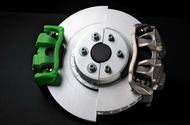The Green Caliper reduces brake dust with lower residual brake torque for greater efficiency
With Euro 7 bringing regulations for brakes and tyres, Continental responds with a novel solution
Euro 7 emissions regulations are due to come into force in July 2025 and, as well as being the toughest yet, their scope goes beyond the usual tailpipe emissions and takes in EVs as well.
For the first time anywhere in the world, cars, vans, lorries and buses will be regulated for particulate emissions from brakes and tyres too. For brakes, that means the tiny particles of dust they generate, and for tyres, it’s the production of microplastics as they wear.
So far, it’s unclear how tyre makers plan to reduce microplastics beyond slowing the wear rate, which is effective and has other benefits as well. But with brakes, component manufacturers are already ahead of the game with some all-new technologies.
One example is the Green Caliper from Continental, which the company revealed following the announcement of the new emissions proposals towards the end of 2022. The Green Caliper has two advantages.
One is that it reduces brake dust and the other is that it increases range by reducing energy consumption. The ‘fist’ caliper does two things at once by dint of something called lower residual brake torque. Normally with hydraulic brake calipers, the pads drag slightly on the disc after the brakes have been released.
But here, the lower residual brake torque between the pads and the disc (after the driver comes off the brakes) is less than 0.2lb ft, which equates to being virtually loss-free. The brakes are used in conjunction with Continental’s MK C2 brake-by-wire system, which takes into account the larger gap between the pads and the disc needed to achieve the lower residual torque, so the driver doesn’t notice any slackness or lack of feel at the brake pedal.
EVs use two sorts of braking: recuperation (aka regenerative) braking and the conventional sort, known as foundation brakes. This caliper is specifically designed to take into account that, according to Continental, foundation brakes are not needed in over 80% of deceleration.
They are still capable of doing the business when it comes to an emergency stop, but because the thermal load on the brakes is much lower, they don’t do as much work as they would on a conventional car.
As a result, the caliper is more compact and the pads are smaller and thinner, something made possible by the reduced wear rate. The bit that straddles the top of the discs is thinner too, giving a ‘low bridge height’, which allows the disc to be of larger diameter, generating more leverage so the brake can produce greater deceleration for the same clamping force.
Overall, the brake is 5kg lighter per corner than a conventional brake, the weight reduction helping increase range and giving handling gains in the form of less unsprung weight.
When it was announced, the Green Caliper had reached the stage where it could be integrated with a vehicle in two to three years.
Source: Autocar
